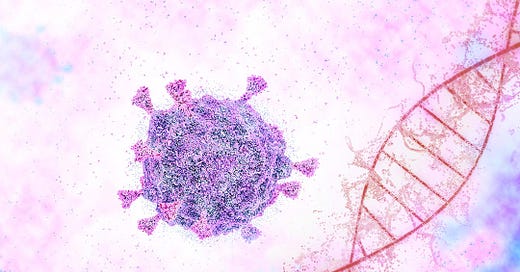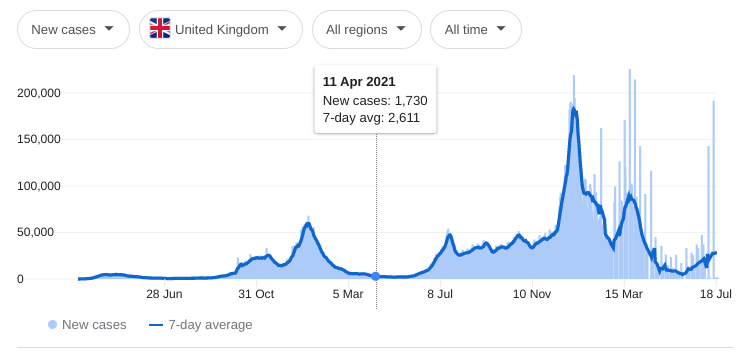The lived experience
Having just recovered from my first bout of COVID-19, I now have the lived experience of what it is like to have COVID-19, albeit a mild infection, and its profound fatigue. At the peak of my infection, I experienced ‘cog-fog’ and the associated consequences of not being able to focus on the task at hand, never mind multitasking and getting through a long ToDo list.
Another issue having COVID-19 has highlighted is that when you are ill and working and self-isolating at home, most organisations, including the NHS, expect you to continue working. Pre-COVID, this was not the expectation. So the new motto is work, work and work some more, but people don’t realise just how unproductive and low quality this work is. Despite having COVID-19, I did three remote clinics and chaired an international online meeting on EBV and MS.
BA5
It is clear that the BA4 and BA5 SARS-CoV-2 omicron variants are finding new hosts more efficiently than previous ones. This is despite herd immunity from prior infections, vaccinations, and boosters. I recently saw a patient who has had three confirmed episodes of COVID-19. Based on the timings of her infections, she has been infected with the alpha, delta and now one of the omicron variants.
Infections or reinfections with BA5 seem to be occurring at the highest frequency of any variant in the pandemic so far. BA5 is more infectious, with shedding occurring longer than other variants. I have a colleague who shed virus for 22 days after a recent infection.
Although there is a perception that this latest wave of infections is associated with lower hospitalisations, ICU admissions and deaths relative to Omicron BA1 and previous variants, this is not necessarily correct. NHS figures are clearly showing an uptick in all three metrics.
Long COVID
The wide use of Paxlovid in vulnerable people is likely to keep hospitalisations lower than they would be otherwise. However, we mustn’t forget the issue of long-COVID that is still occurring despite milder disease and the use of antivirals.
Long-COVID is the elephant in the room and is a major problem at a national level. I am told the long-COVID clinics cannot keep up with the number of referrals. A fascinating finding is that long-COVID may be linked to EBV reactivation in a subset of patients. This implies that the chronic fatigue, cog-fog and the associated cognitive problems may be due to EBV rather than SARS-CoV-2. If this is the case, there may be some overlap between long-COVID, chronic fatigue syndrome patients, and MS-related fatigue. Maybe we should explore anti-EBV agents as a treatment for long-COVID and these related disorders?
Fortunately, I don’t have long COVID. My energy levels seem to be returning, and my cog-fog has cleared. I also manage a very intense HIIT session on an exercise bike on Monday without any consequences.
Many of my patients with long-COVID are telling me it just feels like an exacerbation of their MS-related fatigue. If any of you have long COVID, I would be interested to know if you have had a similar experience?
Antiviral resistance
What is alarming is the recent reports of resistance developing to Paxlovid, which has been widely predicted. This is why we need new antivirals and, ideally, antiviral combinations to prevent resistance.
It is clear that the BA5 is an immune escape variant and has developed new mechanisms to evade the immune system, including suppression of innate immunity and increased infectivity of cells. The mutations BA5 has acquired beyond Omicron BA1, BA2, and BA2.12.1 make it a formidable foe and explain why it is spreading like a proverbial wildfire. Only one therapeutic monoclonal antibody is still effective against BA5, and Evusheld, the combination monoclonal antibody for protection in the immunocompromised population, has lost some effectiveness against BA5. Please note despite Evusheld being licensed by the MHRA, it is not generally available on the NHS.
Original antigenic sin
It also looks like the theory of original antigenic sin is playing out with Omicron. In other words, immunity from vaccines and/or previous infections with earlier strains prevents good quality immune responses to the new strains. Infection with Omicron strain boosts responses from preexisting memory but does not create good quality neutralising responses to the new strains. This then sets us up the conditions for recurrent cycles of infection and explains why some people are getting recurrent infections months or even weeks apart. I know one person who has had two episodes of COVID-19 five weeks apart. This has major implications for future vaccine design, and vaccine responses as new strains get incorporated into the next generation of vaccines may not induce new memory. Please note original antigenic sin occurs with the flu virus and dengue virus and was predicted with SARS-CoV-2 early in the pandemic. Let’s hope it only affects a minority of people.
The next variant
Although we have now learnt to live with SARS-CoV-2, we must remain vigilant. The next variant may come from anywhere and be more virulent than Omicron and escape herd immunity.
So my advice remains the same be careful, avoid high-risk situations and if you can’t mask up. Make sure you are on the NHS’s vulnerable list, which will allow you to access community-based antivirals, and make sure you have had your boosters. For pwMS on immunosuppressive therapies, this means getting your fifth shot.
Paper 1 - EBV and long-COVID
Paper 2 - Paxlovid resistance
The SARS-CoV-2 main protease (Mpro) is a cysteine protease and a validated antiviral drug target. Paxlovid is an FDA-approved oral COVID-19 antiviral that contains the Mpro inhibitor nirmatrelvir and the metabolic booster ritonavir. The emergence of SARS-CoV-2 variants mutations in the Mpro raised the alarm of potential drug resistance. In this study, we aim to discover Mpro drug resistant mutants from naturally observed polymorphisms. Through analyzing the SARS-CoV-2 sequences deposited in Global initiative on Sharing Avian influenza Data (GISAID) database, we identified 66 prevalent Mpro mutations located at the nirmatrelvir binding site. The Mpro mutant proteins were expressed and characterized for enzymatic activity and nirmatrelvir inhibition. While the majority of the Mpro mutants had reduced enzymatic activity (kcat/Km >10-fold decrease), 11 mutants including S144M/F/A/G/Y, M165T, E166Q, H172Q/F, and Q192T/S/V showed comparable enzymatic activity as the wild-type (kcat/Km <10-fold change) and resistance to nirmatrelvir (Ki > 10-fold increase). We further demonstrate that the enzymatic activity and inhibitor resistance of these single mutations can be enhanced by additional substitutions in a double mutant. X-ray crystal structures were determined for six of the single mutants with and/or without GC-376/nirmatrelvir. The structures illustrate how mutations can reduce ligand binding by impacting the conformational stability of the active site. Overall, our study identified several drug resistant hot spots that warrant close monitoring for possible clinical evidence of Paxlovid resistance.
Paper 3 - antigenic sin
Analysis of memory B cell responses to Spike antigen after Omicron BA.1 breakthrough infections provides clues on whether “original antigenic sin” is in play.
Subscriptions and donations
Paid subscriptions to MS-Selfie are being used to administer the Newsletter and associated MS-Selfie microsite currently in development. At the request of several readers, I have now added the option of making a one-off donation. To keep this initiative open to all readers, I would appreciate it if those who can afford a subscription, please subscribe. For active paying subscribers, thank you; your contribution is much appreciated.
General Disclaimer: Please note that the opinions expressed here are those of Professor Giovannoni and do not necessarily reflect the positions of Barts and The London School of Medicine and Dentistry or Barts Health NHS Trust. The advice is general and should not be interpreted as personal clinical advice. If you have problems, please tell your healthcare professional who will be able to help you.
















Share this post